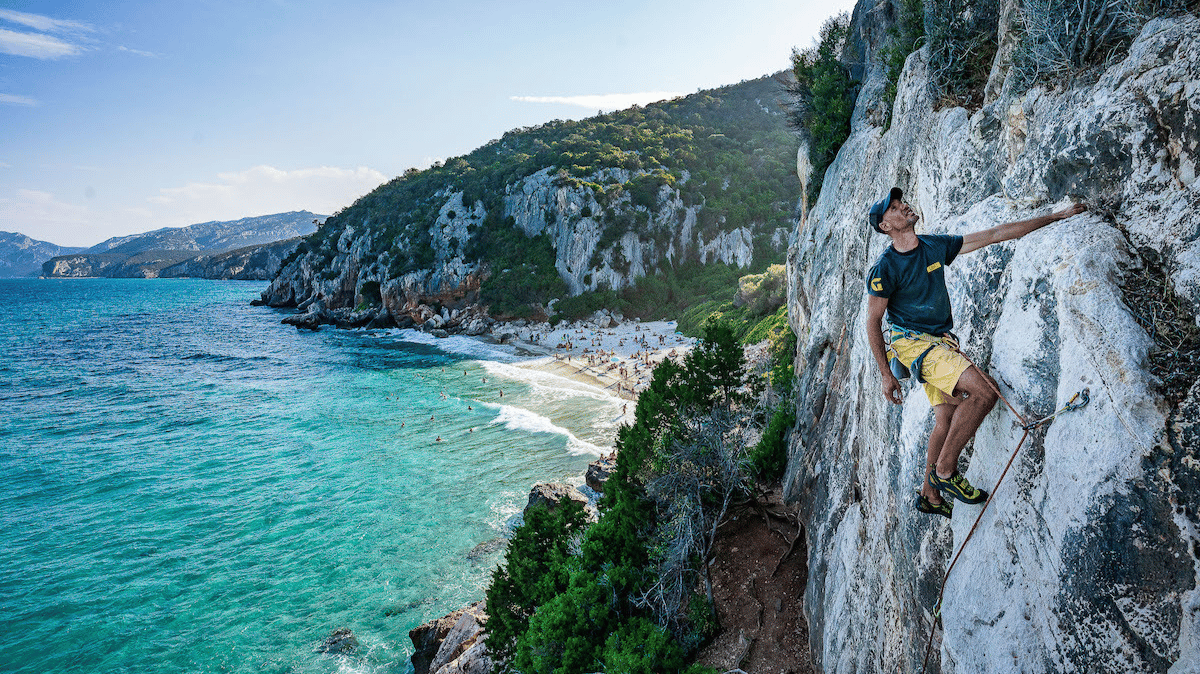Sardinia, an island in the Mediterranean, is part of Italy, known for its unique culture, language (Sardinian), and stunning landscapes. Despite common thinking, Sardinia is not part of Spain, but has a rich history influenced by various cultures.
Sardinia is famous for beautiful beaches like Costa Smeralda and diverse outdoor activities. While often seen as expensive, especially in tourist areas, there are ways to explore Sardinia affordably, with climbing and hiking especially. It's a place where outdoor lovers, like hikers and climbers, can enjoy holidays without spending too much.
Imagine an island where mountains and sea come together to create a playground of adventures. There are ancient forests, deep valleys, and trails that lead to hiking trails and rock cliffs of unmatched beauty. The weather is perfect almost all year, with mild autumn and spring seasons, making it an attractive destination year-round. Thanks to this guide, you’ll discover the wild and beautiful heart of the Mediterranean, learning everything you need to know for your next outdoor adventures. We’ll break down all the information we collected during 3+ years spent organizing climbing and hiking trips, in collaboration with skilled Certified Guides, like Marco and Micol:
A climbing trip for climbers of any level: Sport-climbing and Multi-pitch in Sardinia
The Best Hiking trails of Sardinia
Outdoor sports you can practice in Sardinia
How much Sardinia Costs & Tips for Budgeting your Outdoor Adventures in Sardinia
How To Get To Sardinia: Most Affordable Options
Conclusions
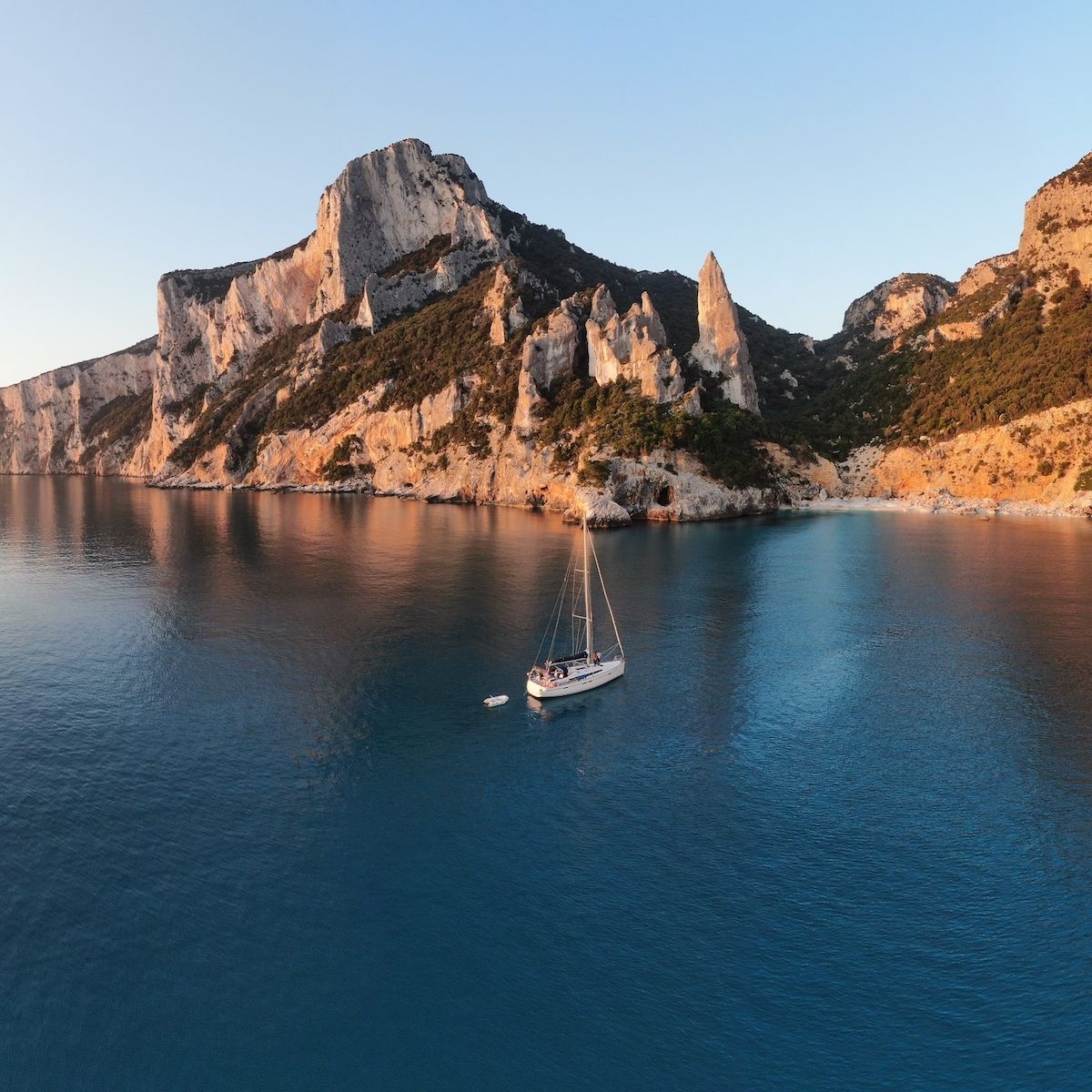
Chapter 1: A Rock-Climbing Guide to Sardinia for Any Level: Best Sport-Climbing and Multi-pitches in Sardinia
Sardinia offers diverse climbing opportunities, including sport climbing and multi-pitch, where the heat of summer and the cool of winter play to the climber's advantage. With seasons dictating the climb, from October to April, climbers of all levels find their haven in different climbing spots, like Cala Gonone with hundreds of routes suitable for various levels. In summer, shaded crags like Ulassai offer respite from the heat. Sport climbing is popular in best from spring to autumn. If you’re a Multi-pitch enthusiast, you’ll find your paradise in Baunei, an area that offers numerous routes with the best conditions in cooler months, from October to April. This chapter’s goal is to provide you with enough information for self-planning your climbing holiday on this magical island.
No worries if you’re still walking your first steps into the world of climbing. In fact, many affordable solutions are available for exploring this land alongside local professional guides and new friends, like multi-day group trips visiting the island’s best crags.
Domusnovas is located in the south, near Cagliari, and offers over 600 routes. It's surrounded by stunning natural scenery, including caves and the Grotto of San Giovanni, making it a hotspot for adventure. Jerzu and Ulassai Together, boast around 1000 single-pitch routes. They cater to all climbers, from beginners to advanced, and offer a mix of challenges. Cala Goloritzè is a destination on its own: this remote bay, known for its picturesque Punta Caroddi, provides climbers with a handful of multi-pitch routes. It's perfect for those seeking a thrilling climb with a view of the Mediterranean Sea. Cala Gonone, nestled on the eastern coast of Sardinia, provides access to over 900 routes that cater to all skill levels, from beginners to advanced climbers. The climbing in Cala Gonone is known for its breathtaking views of the Mediterranean Sea, making it a memorable experience.
Our 5 Best sport-climbing spots in Sardinia
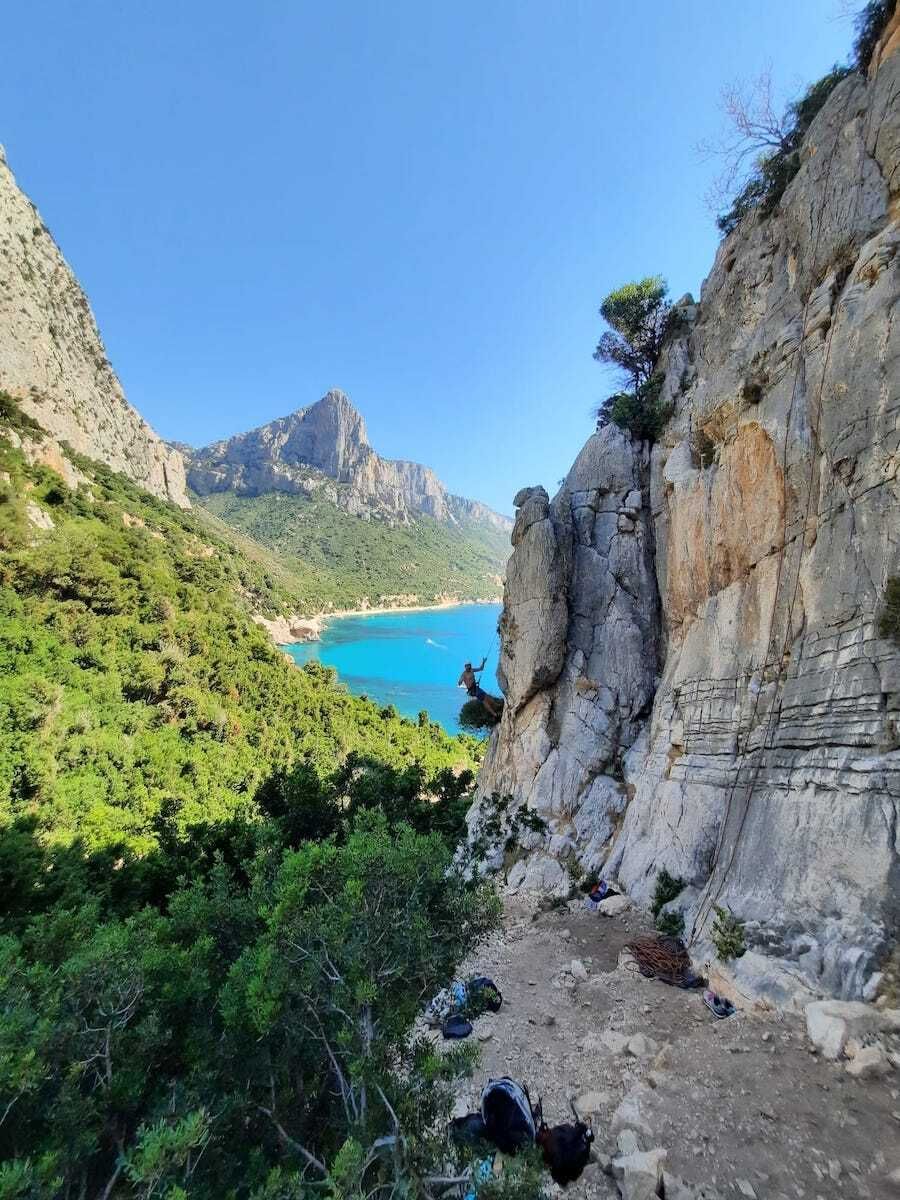
Sardinia is an amazing spot for climbing, with its beautiful limestone offering over 7,000 sport climbing routes. This variety means there's climbing for every level and taste, from crags in the mountains to spots by the sea. Not only is the climbing great, but the island also has delicious food, friendly people, and stunning views. Popular areas like Cala Gonone, Domusnovas, Isili, Ulassai, and Jerzu provide fantastic single-pitch routes, while Supramonte offers big wall adventures. With affordable travel and year-round climbing weather, Sardinia stands out as a top destination for climbers and families alike.
Each of these areas highlights Sardinia's diverse climbing landscape, combining the island's natural beauty with a wide range of climbing experiences.
Cala Gonone is great for climbers at any level, with many routes and beautiful views by the sea. Jerzu and Ulassai offer many easy to hard routes in cool landscapes, and you can find the latest news about them online. Cala Goloritze is amazing for climbing high routes on a big rock by the sea, reached by hiking or by boat. Domusnovas has lots of climbing routes in an old place, good for all skill levels. Isili and Gorropu Gorge are perfect for both regular and traditional climbing, with tough routes on tall rock walls. Let’s break down each climbing area:
Cala Gonone and Gorropu Canyon:
In Cala Gonone, climbers of all skills will find something to love among the 900 sport routes. Beginners can tackle the 401 routes rated between 4a and 6a+, while intermediate climbers have 330 routes ranging from 6b to 7a. Advanced climbers can challenge themselves on the 168 routes between 7a+ and 7c+, and even tackle the 49 routes rated 8a and harder. Those interested in multi-pitch adventures have 20 options to choose from, and there are also a few trad routes for enthusiasts.
Supramonte, located near Cala Gonone on Sardinia's northeast coast, is a climbing paradise featuring limestone cliffs that reach up to 600 meters. This area is home to 10 to 25 climbing routes, with difficulties ranging from moderate to very challenging (6c to 8b). Climbers here can enjoy a variety of styles, including both traditional and sport climbing.
The landscape of Supramonte is characterized by its vertical and steep walls, which are adorned with a diverse array of holds such as crimps, pockets formed by water erosion, tufas, and ribs. This variety makes it an engaging place for climbers who enjoy solving technical challenges.
Among the most famous climbs is "Hotel Supramonte," a particularly noteworthy route that spans 370 meters and is graded at 8a+. Located in the Gorropu canyon, this climb is celebrated for its ten intense pitches that traverse the wall's crimps, tufas, and pockets. Another significant route, "Viaje de Los Locos," stretches over 300 meters and peaks at an 8b+ difficulty. Free-climbed by Sasha Digiulian in August 2014, this route features a series of challenging sections that test climbers' skills and endurance.
Jerzu e Ulassai:
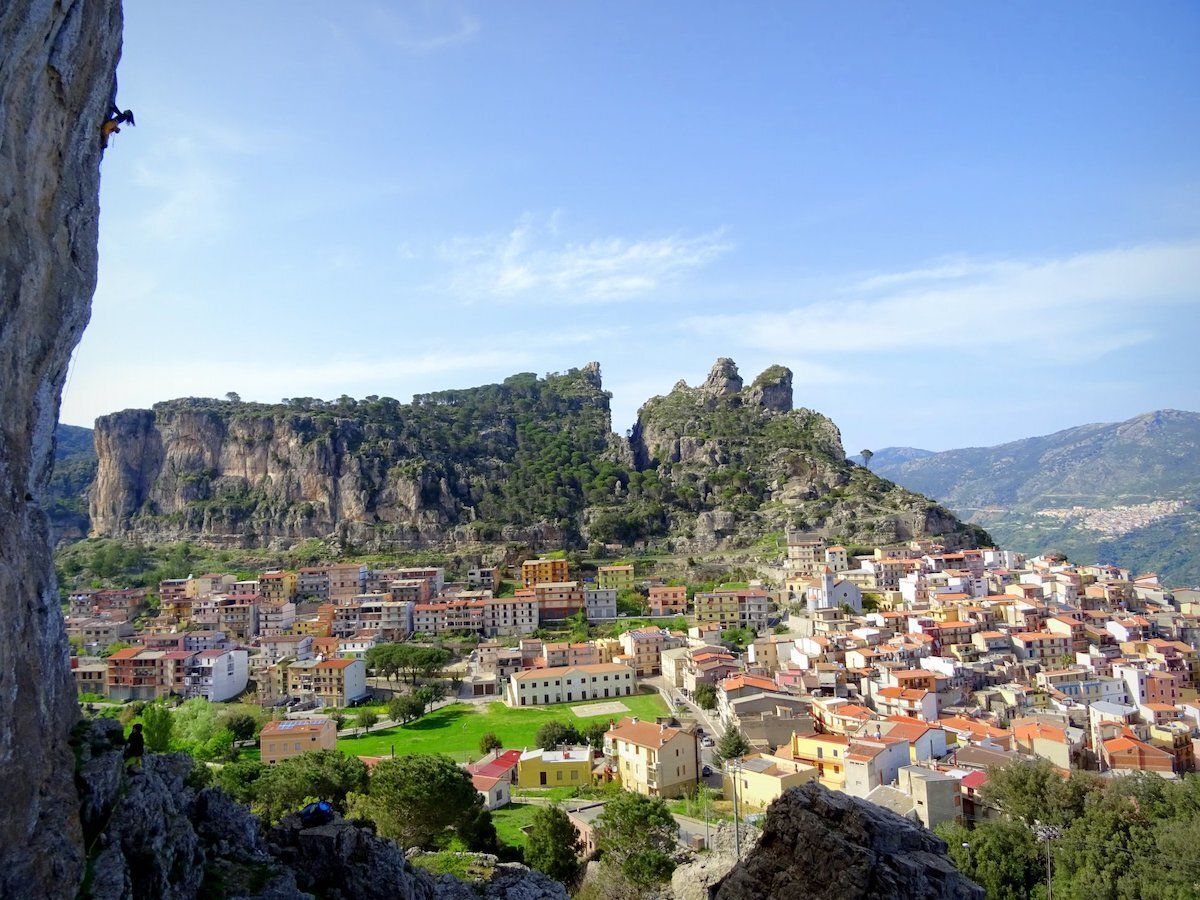
Jerzu and Ulassai in Sardinia are fantastic places for climbers of all levels, with about 1000 single-pitch routes and a few trad climbing spots too. Here's how you can pick the best spot for your climbing adventure based on what you like and how experienced you are:
If You're Just Starting (Grades 4a to 6a+): New climbers have 230 routes that are perfect for getting the hang of climbing. These spots are less tricky and great for learning. For a special experience, head to Baunei near the sea. It has 11 areas just for climbing, offering easy routes with beautiful sea views.
Intermediate Climbers (Grades 6b to 7a): If you've climbed before and want a bit more challenge, there are 350 routes waiting for you. Jerzu is a good place to try. It's known for its climbs that need you to think and use your fingers well, but there are new routes too that might be just right for you.
Advanced Climbers (Grades 7a+ or More): Seasoned climbers have 340 tough routes and 90 even tougher ones to conquer. For an epic adventure, Punta Giradili in Baunei has the longest climbs in Sardinia, with up to 15 pitches! It's easier to start from the top if you're using one rope.
Ulassai and Jerzu are not widely know for their trad climbing opportunitie: in fact, there are just a handful of trad routes, however we suggest to but keep an eye on Instagram @taccumaccu_ulassai and @nannaiclimbinghome for updates.
Click here for a detailed topo of the area.
Domusnovas:
Domusnovas is a climber's dream spot in the south of Sardinia, just 50 kilometers west of Cagliari. It's surrounded by amazing sights like underground rivers, caves, and the famous Grotto of San Giovanni. This 800-meter tunnel through a mountain is at the heart of over 600 climbing routes available here, making it a perfect place for climbers at any level.
Beginners (Grades 4a to 6a+): If you're just starting, Domusnovas has 160 easy routes for you. These routes let new climbers get comfortable with climbing. You'll find gorgeous limestone cliffs in Nebida and Masua, perfect for beginners. Also, Punta Pilocca has easy slabs that are great for your first climbs.
Intermediate Climbers (Grades 6b to 7a): Those with a bit of experience have 260 routes to try. These routes are a bit trickier and help you learn more about climbing techniques. The area around the Grotto of San Giovanni is full of these kinds of climbs. If you like granite, check out Capo Pecora, which has some of the best granite rocks in the area.
Advanced Climbers (Grades 7a+ or more): Seasoned climbers will find 140 routes that are quite challenging, plus 40 routes that are even tougher. Domusnovas offers climbs with difficult overhangs and technical routes that really test your skills. Near Il Muro dei Folletti, just a short walk away, you'll find some of the hardest sport climbing routes.
Domusnovas is like a feast of climbing routes, with 33 areas all centered around the Grotto of San Giovanni. No matter your skill level, you'll find climbs here that fit what you're looking for. The stunning natural beauty and variety of climbs make it a top choice for climbers everywhere.
Isili:
Isili is a special spot in the middle of Sardinia, a bit south, and it's a great place for rock climbing. Even though it's not by the sea, it's known for having lots of climbing routes that make climbers feel like they're floating in the air.
In Isili, there are 260 routes for climbing, perfect for everyone from beginners to pros. These routes are sorted by how hard they are:
60 easy routes (4a to 6a+)
100 medium routes (6b to 7a)
70 tough routes (7a+ to 7c+)
16 very hard routes (8a and up)
Climbers can choose from 13 different areas in Isili, with routes that go from really easy to super hard, between grades 5.8 and 5.14. If you're just starting, "Pietra Filosofale" is the easiest one to try. "Cervo Spaziale" is a popular spot, so it might be crowded. For climbers looking for a big challenge, the "Urania" area has some of the hardest routes, with grades up to 5.14b.
Isili is unique in Oristano, a growing climbing area in Sardinia that offers a mix of rock types like limestone, basalt, and granite. With its variety of climbs and beautiful, challenging overhangs, Isili is a place where both new and experienced climbers can find exciting challenges. "Cervo Spaziale" is the busiest spot, and "Urania" is where you'll find the hardest climbs.
Best sport-climbing in Sardinia for beginners
If you're new to sport climbing and looking for the best places in Sardinia to start, the time of year makes a big difference in choosing your spot. During the winter, Cala Gonone is perfect. It's got safe climbing paths, beautiful views of the sea, and friendly people who can help you learn. But when summer comes and it gets hotter, you'll want to head to Jerzu and Ulassai.
If you’re planning a trip to Cala Gonone, Jerzu or Ulassai for climbing, it might be a good idea to connect with a local climbing center or guide. They can point you to the best beginner-friendly routes and help you have a safe and enjoyable climbing experience in one of the most beautiful parts of Sardinia. Alternatively, you can join other climbers with climbing skills similar to yours on a Mapo Tapo trip to Sardinia, supported by a Local, Certified Mountain Guide and designed to bring you to the best areas depending on the period of the year!
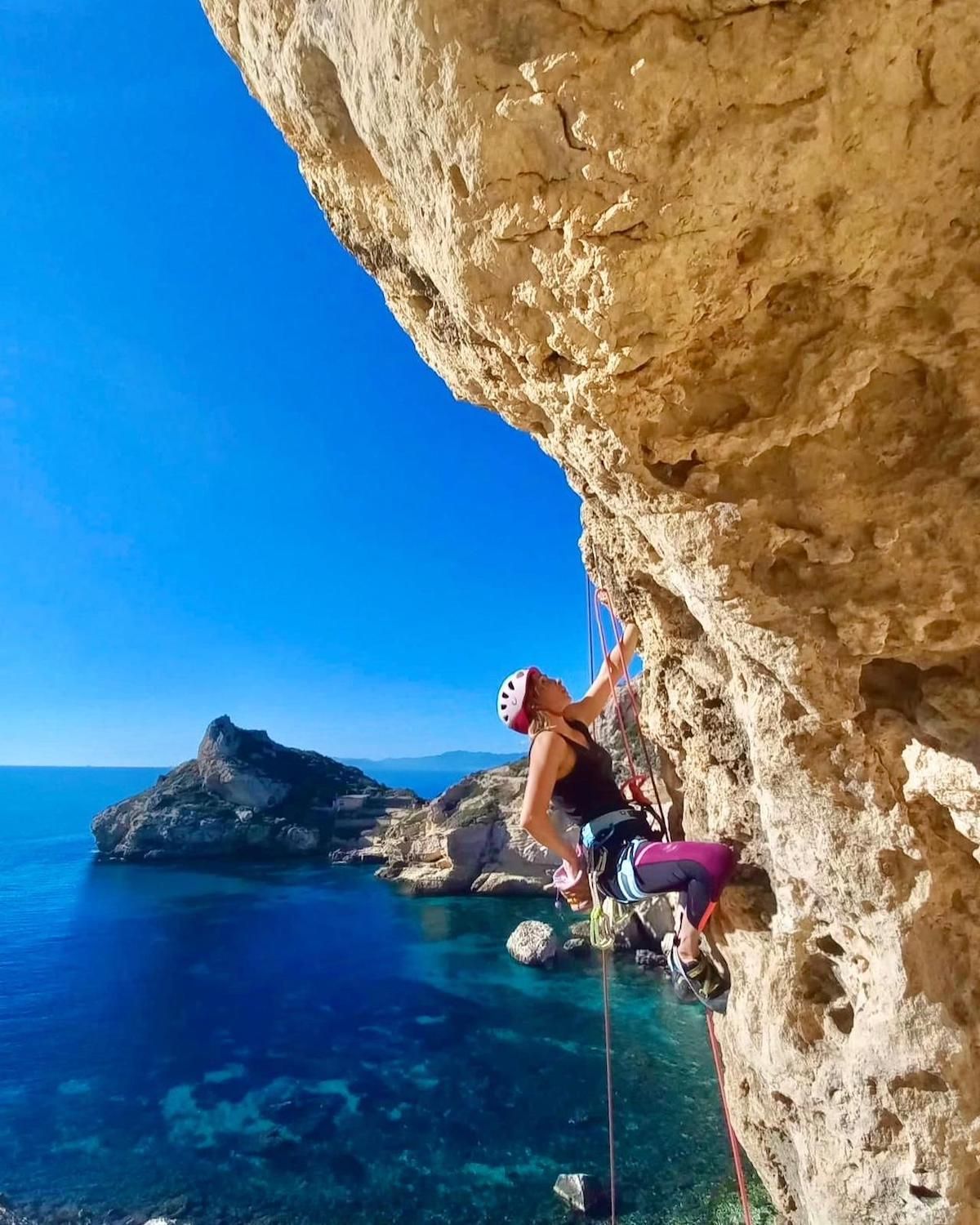
In Jerzu, you'll find lots of beginner-friendly climbs. The rock is really good for climbing, and the climbs aren't too hard, so you can practice and get better while enjoying the outdoors. Jerzu is also a place where they make wine, so it's a cool spot to explore after climbing.
Ulassai is a great choice for summer. It's up in the mountains, so it's a bit cooler, and there are plenty of shaded spots to climb. Like Jerzu, there are climbs that are just right for beginners, and the scenery is amazing—full of beautiful, wild landscapes.
Both Jerzu and Ulassai have everything a beginner needs: safe routes, beautiful nature, and less crowded climbing spots. Plus, you can find climbing schools and instructors to help you out, making sure you have fun and stay safe.
So, if you're planning to climb in Sardinia, remember: Cala Gonone is great for winter, but when summer rolls around, Jerzu and Ulassai are the places to go. They offer a nice mix of easy climbs and beautiful places to see, making your climbing adventure special any time of the year.
Best Multi-pitch Routes in Sardinia
Sardinia is a dream spot for anyone who loves climbing. It's not just any place; it's a special island with about 800 different multi-pitch routes that go up high, making it a fantastic choice for an exciting adventure. We can actually say that the island is distinguished from other climbing destinations, like Kalymnos and Sicily, by its multi-pitch routes: here, you'll find everything from easy climbs for beginners to more challenging ones for the pros, and… a wild environment! After all, it’s where world-class alpinists like Tommy Caldwell, Alex Honnold & Brette Harrington spend their holidays.
Climbing in Sardinia is all about amazing experiences. It's got a bit of everything - from challenging climbs that give you a real sense of achievement to stunning views of the sea. The climbs here are longer and more involved, which means you get to spend more time enjoying the heights and the scenery.
Getting Ready for Your Sardinian Multi-Pitch
Starting your climbing adventure in Sardinia is pretty simple. All you need is an extra rope along with your usual climbing gear. This makes it easy to get ready for your trip, even if you're flying on a budget airline.
Climbing in Sardinia is more than just a sport; it's a chance to be in awe of the beautiful surroundings. With a wide range of climbs for all skills and the beautiful sea as your backdrop, Sardinia offers a unique experience that combines excitement, beauty, and the joy of discovery. So, if you're thinking about where to go for your next climbing adventure, Sardinia should definitely be on your list.
Getting Ready for Your Climbing Trip
In the southwest part of the island, places like Masua and Gutturu Pala offer climbs where the sky meets the sea. If you're near Dorgali and Urzulei, you'll find great spots with different types of climbs, including some that are perfect for those just starting out. Then there's the area around the Gulf of Orosei and Supramonte di Baunei, where climbers can enjoy the wilderness and breathtaking coastline views, including the famous Aguglia at Cala Goloritzé.
Pedra Longa, Cala Gonone: Pedra Longa is a tall rock tower by the sea in Baunei, offering a unique climbing spot with rough and tough rock. It's famous for its beautiful sea views and the only route to the top. The "Marinaio di Foresta" route has 7 pitches, stretching 190 meters across, with the hardest part rated 6a+.
The adventure starts right from the sea and goes down the other side, mixing in some climbing and rappelling. It's a great climb for anyone, local or visiting, any time of year because of its location and length. It's easy to get to, just a 5-minute walk from where you park, and it gives you amazing views, especially of Punta Giradili.
Climbing here is peaceful and rewarding, with stunning scenery. There are two ways down: rappelling or walking down a ridge, which takes about 20 minutes to get back to the base of Pedra Longa. Remember to bring all your climbing gear, including a helmet. You'll need around twelve quickdraws and a rope (having a second one is a good idea for safety).
Dillosauro: In our view, Cala Goloritze has become a bit "overrun" by visitors. The beach, once a hidden gem for rare adventurers, is now swamped by crowds of tourists trekking the once-secluded path, renovated by local authorities. A spot that offered solitude and a rugged coastline now mirrors a bustling city center during peak shopping season. Why not climbing in pure Mapo Tapo style, then? The Dillosauro an amazing and unique rock made of red granite, found on the east coast of Sardinia, is definitely an off the beaten track climbing destination. The climb is short – just 2 pitches – but because it's high up, a bit tricky, and has incredible views, it really deserves a visit if you’re willing of hiking 1 hour for a couple of pitches graded 6b/c and 6b. (_Getting to Jurassic Park from Quirra, is currently blocked by legal orders, and it's unclear when it will open again. So, you need to go from the north, starting at Marina di Tertenia and Porto Santoru, which takes about 1 hour of walking.)
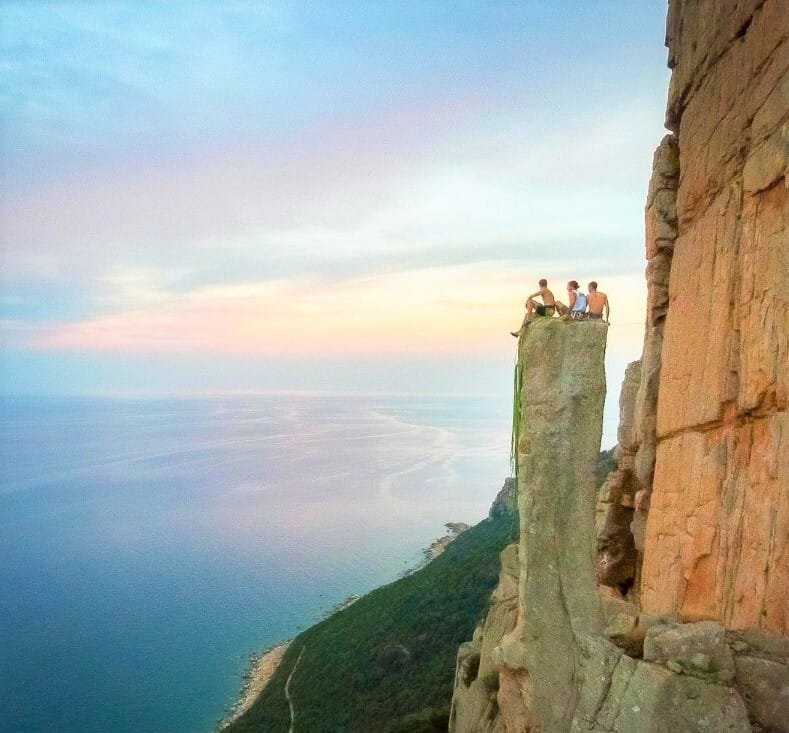
Pan di Zucchero: Pan di Zucchero, near Sardinia's Iglesiente coast, stands as the tallest sea stack in the Mediterranean, enticing climbers with its blend of adventure and beauty.
Climbers flock to Pan di Zucchero for its pristine limestone walls that offer both challenge and reward. The stunning surroundings, visible from the boat ride to the base, enhance the experience. L'Incubo di Francesco, a 50-meter climb on perfect compact limestone, is a standout route, showcasing the variety of climbing experiences available. Logistics are straightforward: a moderate fitness level is required, and a short boat ride from the coast brings climbers to the base. From there, climbers ascend to enjoy panoramic views of the Iglesiente coast before choosing between a via ferrata traverse or an aerial rappel back to the boat for the descent.
Climbing Pan di Zucchero provides not just physical challenge, but a sensory experience against the backdrop of the Mediterranean's azure waters.
Other climbing opportunities
For trad climbing in Sardinia, the most popular spots include Jurassic Park in Su Santu and Gola di Gorroppu in Southern-east Sardinia, each offering around 10 routes. Dorgali, close to Cala Gonone, provides about 30 routes, while Capo Pecora, near Buggerru on the west coast, has potential with approximately 20-30 routes across at least 10 sectors.
Bouldering is also a hidden gem in Sardinia, particularly along the northern coast, developed by locals over 20 years but still largely unknown to European climbers. The "Primitive Bouldering" crew is actively developing this area. For more detailed information on bouldering spots, a guide from 2022 is available at Pietra di Luna, although it may not cover all developed potentials.
Chapter 2: Hiking trails you shouldn’t miss in Sardinia
Hiking in Sardinia is like stepping into a beautiful, wild world. This island in the Mediterranean Sea is perfect for everyone who loves to hike, from beginners to experts. Sardinia has all kinds of trails, from rocky coasts and deep valleys to quiet forests and tall mountains. Hiking here means you get to see some of the most beautiful places and views you can imagine. In this chapter, we’ll focus on some of the best hikes Sardinia offers, starting from the most famous one, the “Selvaggio Blu” trek. For detailed budgeting and costs of hiking in Sardinia, including self-guided hikes, group trips, or guided multi-day hikes, please check out Chapter 4.
Hiking the most famous hike in Sardinia: the “Wild Blue” Trek or “Selvaggio Blu”
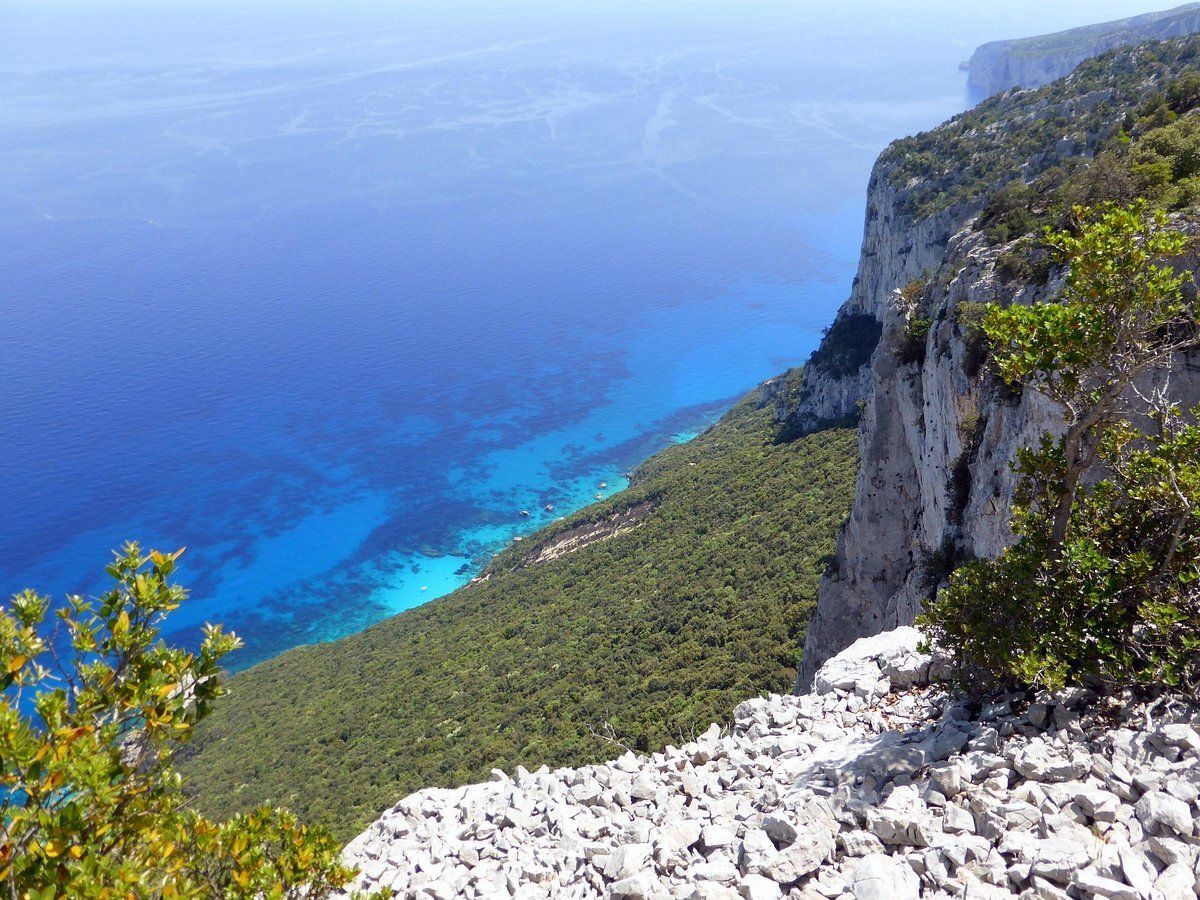
In this chapter we have to talk about the Selvaggio Blu, often called the most challenging hike in Italy. But calling it just "challenging" doesn't fully capture what this hike is about. For five days, you'll hike through Sardinia's wildest parts, places you can't get to any other way. The Selvaggio Blu takes you through 43 km in the beautiful Ogliastra area, along a path that feels like it's from another time. You'll see amazing mountains, huge cliffs, and the stunning blue sea. It's a journey far from cities and towns, where you can really feel nature's beauty. Here’s the breakdown of Selvaggio Blu, stage by stage:
Day 1: Arrival Day
Where to Meet: Arrive at Rifugio Goloritzè around 6 pm. There's a bus from Cagliari to Baunei, and we can pick you up from Baunei.
First Night: You'll set up your tent at the campsite or possibly stay in a shared bungalow, based on what's available. Your Guide will arrange a welcome dinner at the restaurant to fuel you up for the next day.
Day 2: The Journey Begins
From/To: Start at Santa Maria Navarrese, aim to reach Ginnirco camp.
Details: It's a 13 km hike with a 7-hour trek, going from sea level up to 750m. This part of the hike is pretty traight-forward, a great way to start.
Highlights: No rope descents or climbing, just a solid hike and amazing views.
Day 3: Descending to Beauty
From/To: Moving from Ginnirco down to the cove of Portu Pedrosu, then up to Genna ‘e Mudrecu.
Details: Today's hike is 11 km and will take about 8 hours. You’ll start high and go down, then back up again.
Highlights: Expect rugged terrain but rewarding views and a refreshing dip in the sea. Day 4: Exploring Ancient Paths
From/To: Heading from Genna ‘e Mudrecu to Su Porteddu.
Details: This 7 km leg of the journey will also take about 8 hours.
Highlights: You'll see old shepherd huts and the beautiful Cala Goloritzè. This night, enjoy a real shower and dinner!
Day 5: The Challenge Increases
From/To: Moving from Su Porteddu to Bacu Padente.
Details: Cover 10 km in 8 hours, with a bit more elevation change and some rope descents.
Highlights: Incredible views and passages made by shepherds await.
Day 6: The Grand Finale
From/To: The final trek from Bacu Padente to Cala Sisine.
Details: Another 10 km, 8-hour day, ending with a victory dip in the sea.
Highlights: The most significant rope descents and a walk through shady forests.
Day 7: Departure Day
Wrapping Up: After breakfast at the Rifugio, it's time to say goodbye. If you need to get back to Cagliari, there's a bus at 9:30 am, and your Guide will probably help you catch it.
Selvaggio Blu is more than just walking; you'll need ropes, harnesses, and helmets. These tools are not just for safety; they also let you see incredible views. Even when it gets tough, the breathtaking sights of cliffs diving into the blue sea will give you a boost. The Selvaggio Blu is like no other hike. You won't find easy paths here. Instead, you'll climb over rocks and explore a wild coastline full of beaches, blue waters, cliffs, and ancient trees. It's a chance to see nature at its most wild and beautiful. Several Local Companies will help you set and plan your hiking adventure, so we recommend checking in if you think you’re not autonomous in rappelling down and orienteering through rocky paths. If you want to check out the route, here’s you can download the GPX file.
Accessing Selvaggio Blu
You have several options for accessing Selvaggio Blu. If you're flying into Cagliari and want to use public transport, here's what to do: Go from Cagliari airport to the bus station and catch the 103 bus. To find out when the bus leaves, check Rome2Rio or Google Maps. The bus ride to Baunei takes about 3 and a half hours. Once you get to Baunei, we can arrange to pick you up and take you to the Rifugio.
If you're coming in a group, you could split the cost of a taxi. A taxi from Olbia airport directly to the Rifugio is about €260 ($280) and fits up to 8 people. From Cagliari airport, it's a bit cheaper at €240 ($260) each way.
Just so you know, getting to Baunei from Olbia isn't easy with public transport. If you end up flying into Olbia, you might want to rent a car or find another way to get here, like a taxi or ride-sharing.
Three Other Hikes you shouldn’t miss in Sardinia
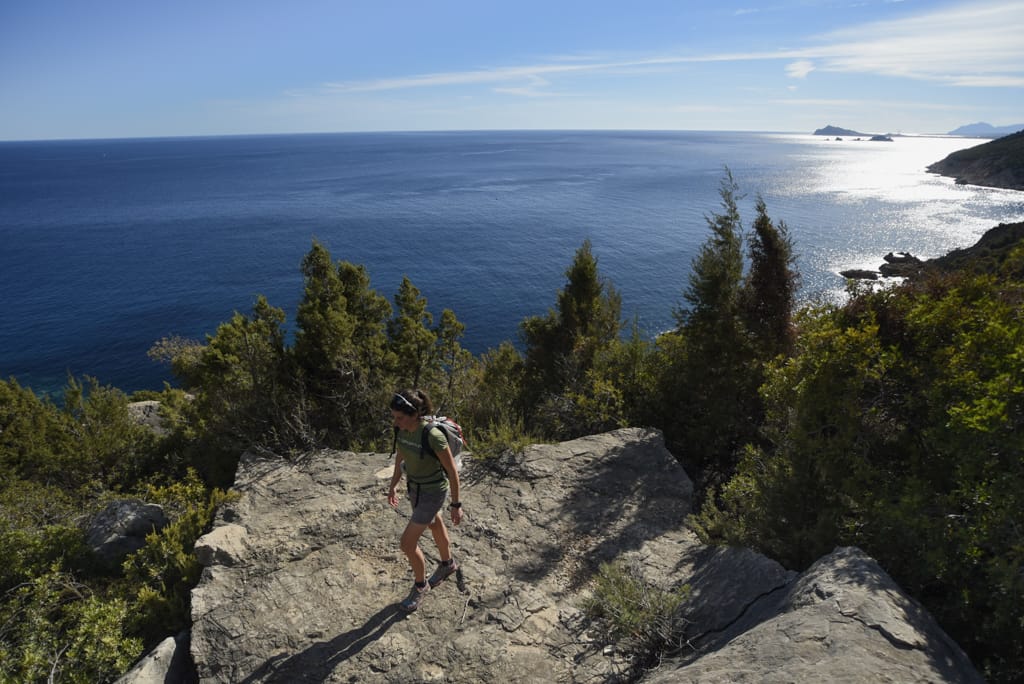
Besides the famous Selvaggio Blu (also known as the “Wild Blue”) trek, there are three other paths that really show off the best of what Sardinia's nature has to offer. Each one is special in its own way and can give everyone from beginners to experienced hikers an adventure they'll never forget. Of course, we thought it would be ideal to pack all of these itineraries in a proper 5-day hiking group trip. Micol, long-time partner of Mapo Tapo and Certified Hiking Guide, made sure to design a satisfying and adventurous trip for those who are looking for something different than the standard Selvaggio Blu.
Pedra Longa to Punta Giradili, A taste of Selvaggio Blu - Check the itinerary here
Starting Point: Your adventure begins at the stunning Pedra Longa rock, a favorite spot for people who love taking photos and enjoying nature.
Elevation Gain: You'll go up about 850m, showing how tough this trail can be.
Distance: The path stretches about 14km along Sardinia's wild coastline.
Estimated Time: Plan to spend around 6 hours on this hike to really enjoy what it has to offer.
Fitness Level: You need to be in really good shape for this hike, as it involves some steep climbs.
Experience Level: It's a great choice for hikers who've been on a few trails before and can handle a bit of a challenge, with beautiful views as your reward.
Cala Fuili to Cala Luna (one-way) - Check the itinerary here
Starting Point: Your journey starts at Cala Fuili beach, where beautiful blue waters meet wild cliffs.
Elevation Gain: This path is easy to climb, making it as welcoming as it is beautiful.
Distance: It's a short walk, only 5.5km, perfect for a quick trip into nature, with 220m of elevation gain.
Estimated Time: You can get to the stunning Cala Luna in around 2 hours.
Fitness Level: This easy hike is great for anyone, giving you a taste of Sardinia's beauty without too much effort.
Experience Level: Whether you're new to hiking or have done lots of it, this trip shows off one of Sardinia's famous views, and it is great for families and hikers with little experience or fitness level.
Consider to double the difficulties if you’re planning to be back at the starting point.
Gorropu Gorges (one-way) - Check the itinerary here
Starting Point: Start your adventure at Sa Barva Bridge and head straight into Sardinia's wild heart.
Elevation Gain: The trail goes up 400m, taking you past old rocks full of stories.
Distance: It's 8km long and takes you deep into the stunning Gorropu Gorge.
Estimated Time: Plan to spend about 5 hours exploring this old and beautiful place shaped by nature.
Fitness Level: You'll need to be pretty fit for this hike since it's quite a challenge but very rewarding.
Experience Level: This hike is best for people who've hiked a bit before. It takes you through some of Sardinia's most beautiful spots that you'll always remember.
Chapter 3: Other Outdoor sports you can practice in Sardinia
In this chapter, we're going to show you the exciting side of Sardinia that goes beyond walking on trails and climbing rock cliffs. Sardinia is a great place for anyone looking to add a little excitement to their outdoor adventures.
If you like the idea of climbing but want something a bit different, try the via ferratas in Sardinia. These are special climbing paths that have ropes and ladders to help you up. They're a fun way to see some amazing views from high up.
For those who love the water, Sardinia's beaches are perfect for surfing. The waves are great for both beginners and experts, so everyone can have a good time. And the water is so clear, making it awesome for kayaking and snorkeling too. You can paddle around to find secret spots or float above the fish and see what's under the sea.
So, let's dive into all the cool sports you can do in Sardinia.
Sardinia is full of places to explore, whether you're up for climbing, kayaking, or just enjoying the natural beauty. Each area offers its own unique adventures, making Sardinia a perfect spot for outdoor sports fans.
Southern Sardinia Places like Cagliari, Iglesias, and Villasimius are just the start. Southern Sardinia is a playground for adventure lovers. You can climb up the big limestone cliffs, kayak along untouched coasts, and dive to see colorful sea life. It’s an exciting place for outdoor fun against a stunning Mediterranean backdrop.
Ogliastra In small villages like Ulassai and Baunei, you'll find the secrets to a long life with great food and wine. You can try lots of activities here like rock climbing, trekking, riding ebikes, kayaking, snorkeling, and diving, all while exploring Sardinia's Blue Zone.
Supramonte Places like Dorgali, Cala Gonone, and Orosei are part of Supramonte, a wild area that seems untouched by time. Here, the mix of rocks, water, and plants shows you what the earth might have looked like at the beginning.
Gennargentu In the shadows of Gennargentu, Sardinia’s tallest mountain, tiny villages like Aritzo and Fonni welcome you. The area is gorgeous in spring, and you’ll fall in love with the locals' warm hospitality. Hiking here is the best way to see the amazing views.
Surfing in Sardinia
Sardinia is a great place for surfing, especially on its west coast, which some people call "little Australia" because of its big waves and beaches that aren't too crowded. Italy has lots of spots for surfing, but Sardinia stands out. It has perfect spots for both beginners and expert surfers. You'll find good waves here for about 200 days each year, mainly from autumn to spring, with waves sometimes over 3 meters high. This makes it perfect for all surfers, whether you're just starting or you've been surfing for years. Plus, the beautiful surroundings make it even better. You'll find the biggest and most reliable waves in the winter, from November to April.
If you're going to Sardinia in the summer, you can still find awesome waves, especially if you're just starting to surf or if you're not super advanced yet. The warm season is usually when surfers want to hit the waves, but if you're from Northern Europe looking for an ideal surf spot, Sardinia is the place to go! Two spots definitely stand out among all the others.
Capo Mannu is the best spot in Sardinia for skilled surfers, with big waves often coming in. It's not for beginners because of dangers like sharp rocks and strong currents, but they can definitely find a safe spot when the swell is big enough to produce waves also for the long-boards, on the left side of the spot. However, if you're new to surfing, the Costa Verde area has lots of safer spots perfect for starting out.
The San Nicolao beach is on Sardinia's southwest coast, known for its shallow waters, smooth sandy bottom, and the fun of sinking your toes into the soft sand. It's a great spot for hanging out in the water or recovering after surfing a wave, offering a break from rocky seabeds. Nearby, behind the beach's large dunes, there's a beautiful pine forest with trails perfect for mountain biking or walking, adding to the area's charm.
Mountain Biking and Snorkeling
Sardinia is a playground for outdoor sports enthusiasts, offering crystal-clear waters for snorkeling, strong winds perfect for windsurfing, and rugged landscapes ideal for mountain biking.
Snorkeling at Tavolara - Punta Coda Cavallo in Sardinia is a great adventure. You start from a place called San Paolo and go into clear blue water. You'll stop at cool spots like Molara's Natural Pools and some beautiful beaches where you can see lots of fish and pretty underwater plants. This snorkeling trip lets you take your time at each spot, so you really get to enjoy seeing all the underwater life.
For mountain biking in Sardinia, one highlighted trail is the Giro Costa Smeralda, known for its stunning coastal views and wineries offering tastings. Another recommended route is Orosei - Monte Tuttavista, offering a challenging ride with impressive elevation. Both routes showcase Sardinia's beautiful landscapes, making them great options for biking enthusiasts looking for an adventure.
Chapter 4: How much Sardinia Costs? + tips for Budgeting your Outdoor Adventures in Sardinia
Sardinia is a dream spot for people who love climbing and hiking. It's not as expensive as you might think, especially if you avoid the fancy Costa Smeralda area. The real magic of the island is in its quiet beaches, small towns, and the paths and cliffs that are perfect for your outdoor adventures. Going there when it's not the busy season can save you money and let you enjoy its peaceful beauty almost by yourself.
Even though Sardinia might be cheaper to live in and visit than many places in Italy, and definitely less expensive than places like the UK, Scandinavia, or North America, it's still full of adventure and beauty. For people who love climbing and hiking, it's a great place to explore without spending a lot. If you skip the few very touristy spots, you'll find an island full of culture, history, and natural wonders, just as lovely as other parts of Italy, but without the big costs.
Eating out is affordable if you know where to go. A pizza can cost between about $8 and $20. A full meal with drinks in a simple restaurant might be around $22, but in a fancy place, it could go up to $75 or more. Staying in Sardinia can also be budget-friendly. In the quieter months, you can rent an apartment for about $50 to $65 a night or stay in a hotel for $75 to $130. In the summer, prices do go up a lot.
Sardinia has lots of beautiful places that won't cost you much. If you're careful with your money, you might spend around $55 to $87 a day. Camping is super cheap, around $11 to $22 a day. Or you can find a simple room for about $22 to $27 per person a night. If you want to spend a bit more for comfort, you might use about $130 a day.
How Much a Climbing Trip to Sardinia Costs?
For hikers and climbers, guided tours are a great way to see the island. A one-day guided hike can start from about $55, and if you want to go for more days, it could cost around $165. Climbers can find day-long guided climbs for about $110 if you’re a group, and longer adventures might be over $275.
Picture a 7-day trip to Sardinia where you climb for 4 days and spend the rest exploring cool places and chilling at the beach. Mixing exciting climbs with visits to cultural places and beach time costs about $1080 if we don't count the extra climbing stuff. Adding a climbing guide, renting climbing gear, and buying a climbing guidebook brings the total to $2280. This plan shows you how much you might spend on a great Sardinia trip that combines climbing adventures with enjoying the island's culture and beautiful beaches.
Item | 1-person Autonomous Climbing Trip | 1-person Guided Climbing Trip | 3-people Guided Climbing Trip | |
|---|---|---|---|---|
Accommodation | $400 | $400 | $400 | $300 |
Flight from Milan to Olbia | $150 | $150 | $150 | $150 |
Rental car & Local Transport | $250 | $250 | $250 | $250 |
Luggage cost | $50 | $50 | $50 | $50 |
Guiding fee | $0 | $1000 | $400 (per participant) | Included |
Climbing gear rental | $0 | $200 | $200 | Included |
Guidebook | $30 | $30 | $30 | $0 |
Food & Drinks | $200 | $200 | $200 | $200 |
Total Cost | $1080 | $2280 | $1680 | $950 |
How Much a 5-day Hiking Trip to Sardinia Costs?
If you’re planning a 5-day hiking trip in Sardinia, this table helps you see the possible costs, whether you're going solo, with a guide, in a small group, or on a special trip like Mapo Tapo's Hiking in Sardinia, which seems to be the most convenient solution if you’re looking forward to a hiking guided trip.
Item | 1-person Autonomous Hike | 1-person Guided Hike | 3-people Guided Hike | |
|---|---|---|---|---|
Accommodation | $300 | $300 | $300 | Included |
Flight from Milan to Olbia | $150 | $150 | $150 | $150 |
Rental car | $200 | $200 | $200 | $190 |
Luggage cost | $50 | $50 | $50 | $50 |
Hiking guide | $0 | $900 | $300 (split cost) | Included |
Hiking gear rental | $0 | $150 | $150 | Included |
Guidebook | $20 | $20 | $20 | $0 |
Food & Drinks | $150 | $150 | $150 | $150 |
Total Cost | $870 | $1920 | $1320 | $990 |
How Much the Selvaggio Blu Trek Costs?
If you're dreaming of tackling the Selvaggio Blu trek in Sardinia, here's a quick look at what it might cost. This table compares doing the trek on your own, with a guide, or as part of a small group.
The table covers everything from where you'll stay, your flight, car rental, and even the little things like your guidebook and snacks. This will help you see how much money you might need for a trip like this, whether you're going solo, with friends, or through a company that sets everything up for you.
Item | 1-person Autonomous Selvaggio Blu Trek | 1-person Guided Selvaggio Blu Trek | 3-people Guided Selvaggio Blu Trek |
|---|---|---|---|
Accommodation | $300 | $300 | $300 |
Flight from Milan to Olbia | $150 | $150 | $150 |
Rental car | $250 | $250 | $250 |
Luggage cost | $50 | $50 | $50 |
Trekking guide | $0 | $900 | $300 (per participant) |
Trekking gear rental | $0 | $200 | $200 |
Food & Drinks | $200 | $200 | $200 |
Total Cost | $980 | $2080 | $1480 |
Chapter 5: How To Get To Sardinia: Most Affordable Options
Depending on your needs, accessing Sardinia shouldn’t be too much of a hassle. If you’re on a budget, you can fly to airports in Cagliari, Olbia, or Alghero, the three main airports you’ll find in Sardinia. Flying directly to one of the island's three main airports is convenient, with budget airlines offering competitive prices from major European cities. This solution will also be the most effective one for travelers flying from US.
Another option is available of course: taking a ferry from places like Rome or Milan is another cheaper, yet slower, option. Buying tickets early and traveling when it's not busy can save money, and you can bring as many luggages as you can carry - quite important if you’re traveling for some outdoor adventures! Sometimes, flying to a big city in Italy and then taking a ferry to Sardinia can also be cheaper, especially if you like seeing the ocean, but logistically more demanding.
Fly to Sardinia: Best Options and Logistics
For a trip to southern Sardinia, Cagliari Airport, or Cagliari Mario Mameli Airport (CAG), is your best bet. It's close to the city and has a train station right near it. It's the main airport for Ryanair flights in Sardinia. Get to Cagliari by:
Car, in about 10 minutes
Train ride from the airport station, which leaves every 6 minutes and takes 7 minutes. While buses are available, the train is faster and often cheaper.
Private transfer, if your’re a large groups with lots of bags. Taxis outside arrivals offer a fixed rate to the city, making them a good choice for those with heavy luggage.
For the northwestern part, Olbia Costa Smeralda Airport (OLB) is the go-to: fewer budget airlines operate here, however in our opinion it offers a good mix between low-cost flights, frequency and distance to the best climbing spots of the entire island. ****
Alghero Airport is another good choice for the northwestern or central areas, with many budget flights from Italy and Europe. it is the smallest airport in Sardinia, and it is designed to make it easy for visitors to get to the Riviera del Corallo area. This might be the best airport between the three if you’re a surfer.
I general, flying to Sardinia can vary in cost depending on whether you're traveling in the high or low season.
During the high season, which includes summer months and holidays, prices for flights can be higher due to increased demand. For example, flights from New York to Sardinia in the summer might be found around $539 for a round trip with stops, showing that deals are available even in peak times if you search around.
In the low season, typically outside the summer and major holiday periods, you can find significantly cheaper flights. For instance, traveling from New York to Sardinia with stops can cost as low as $539 for a round trip, with prices slightly varying based on the number of stops and the airlines chosen.
Traveling to Sardinia from big European cities like London or Milan varies by season, affecting both availability and price.
From London: In the high season, summer months when demand is higher, prices for direct flights to Sardinia can go up significantly. You might find round-trip flights starting from about $135, but they can go much higher depending on how early you book and the airline. During the low season, autumn through spring excluding holidays, prices drop, and you could snag deals as low as $56 for a round trip.
From Milan: Being closer, flights from Milan to Sardinia are generally more frequent and can be cheaper. In the high season, prices are higher but may not spike as much as from London due to the shorter distance. Expect to find round-trip flights from about $100 and up. In the low season, you'll find even better deals, possibly below $100, especially if you're flexible with your travel dates and book in advance.
Keep in mind, prices can fluctuate based on factors like booking time, specific travel dates, and airline specials. As you may notice, even in the low season there are affordable options for travelers willing to be flexible with their travel plans.
How To Get To Sardinia By Ferry: Best choice for larger groups
Flying to Sardinia and renting a car when you get there is usually the easiest and fastest option, especially if you're going there to hike and climb. But, if you're bringing your own car or lots of luggage, taking a ferry might work better for you.
You can catch a ferry to Sardinia any day of the year. While they're a bit less frequent in winter, you can always find something: usually, you’ll find a few departure times, late in the morning around 10 AM, and late in the night, around 10 PM. Just remember, taking your car on a ferry can be pretty expensive, and you'll need to book way ahead to get a good deal, especially in summer.
Daytime ferries are faster, taking about 5.5 to 6.5 hours, depending on where you start. The quickest ferry starts in Piombino and goes to Olbia. Overnight ferries are longer, from 8.5 to 12 hours, but can be cheaper and let you sleep in a cabin.
Ferries have comfy cabins if you're going overnight, but there are also seats if you prefer. If you’re close to the dirtbag life and want to save some money, consider spending the night sleeping on one of the many (uncomfortable) couches you’ll find onboard. If you’re going to Sardinia for bouldering, here’s a pro-tip: most of the boats allow you to bring your crash-pad on the deck. Just open it up on the floor and you’ll get an amazing, comfortable mattress where to sleep on! During the trip, the lights won’t be switched off during at night, and you could occasionally hear the TV screens playing some advertising. That being said, the ferry have lots of facilities, like places to eat and play areas for kids, even if a coffee could cost up to 2.50€, which is pretty expensive for Italy.
Lots of companies run ferries to Sardinia, linking it to places in Italy and Europe like Rome, Naples, France, and Barcelona. Not all ferries go to the same places in Sardinia, though.
So, deciding between flying or taking a ferry really depends on if you need to bring a car and how quickly you want to get there.
Traveling to Sardinia by ferry is straightforward, whether you're coming from within Italy or an international port. Here's a simplified guide to help you plan your journey.
How to Reach Sardinia by Ferry from Italy: For exploring Sardinia, Cagliari and Olbia are the top ports to consider. Cagliari is perfect if you're looking to see the southern and central parts of the island, while Olbia gives you easy access to the northeastern coast and the stunning Costa Smeralda.
From Civitavecchia (near Rome) to Olbia, the trip usually takes about 5 to 8 hours, depending on whether you travel by day or night. The ferries here are often hydrofoils in the summer.
Going to Cagliari from Civitavecchia takes around 13 hours, and sometimes the ferry stops at Arbatax, extending the trip to about 15 hours.
Genoa to Olbia is another popular route, with a journey time of 10 to 12 hours, offering daily services. This is the most recommended option if you’re traveling to Sardinia for bouldering in the Northern Areas or sport-climbing on the East Coast.
Shorter routes like Livorno to Olbia take about 9 hours and are a great way to get to northern Sardinia.
How to Reach Sardinia by a European Port: If you're coming from outside Italy, there are ferries from France and Spain that can take you directly to Sardinia.
The Ajaccio (Corsica) to Porto Torres (northern Sardinia) route takes about 6 hours, perfect for a quick transition from Corsica.
From Barcelona to Porto Torres, the journey is around 12 and a half hours, providing a direct link from Spain to Sardinia.
Nice to Porto Torres offers a longer scenic route, ranging from 10 to 12 hours based on the season and the ferry used.
Remember, ferry schedules and routes change often, so it's a good idea to check the latest information before you book. Choosing between Cagliari and Olbia mainly depends on which part of Sardinia you're interested in exploring. Both ports offer excellent gateways to the island, whether you're coming from another Italian city or hopping over from another European country.
Chapter 6: Conclusions
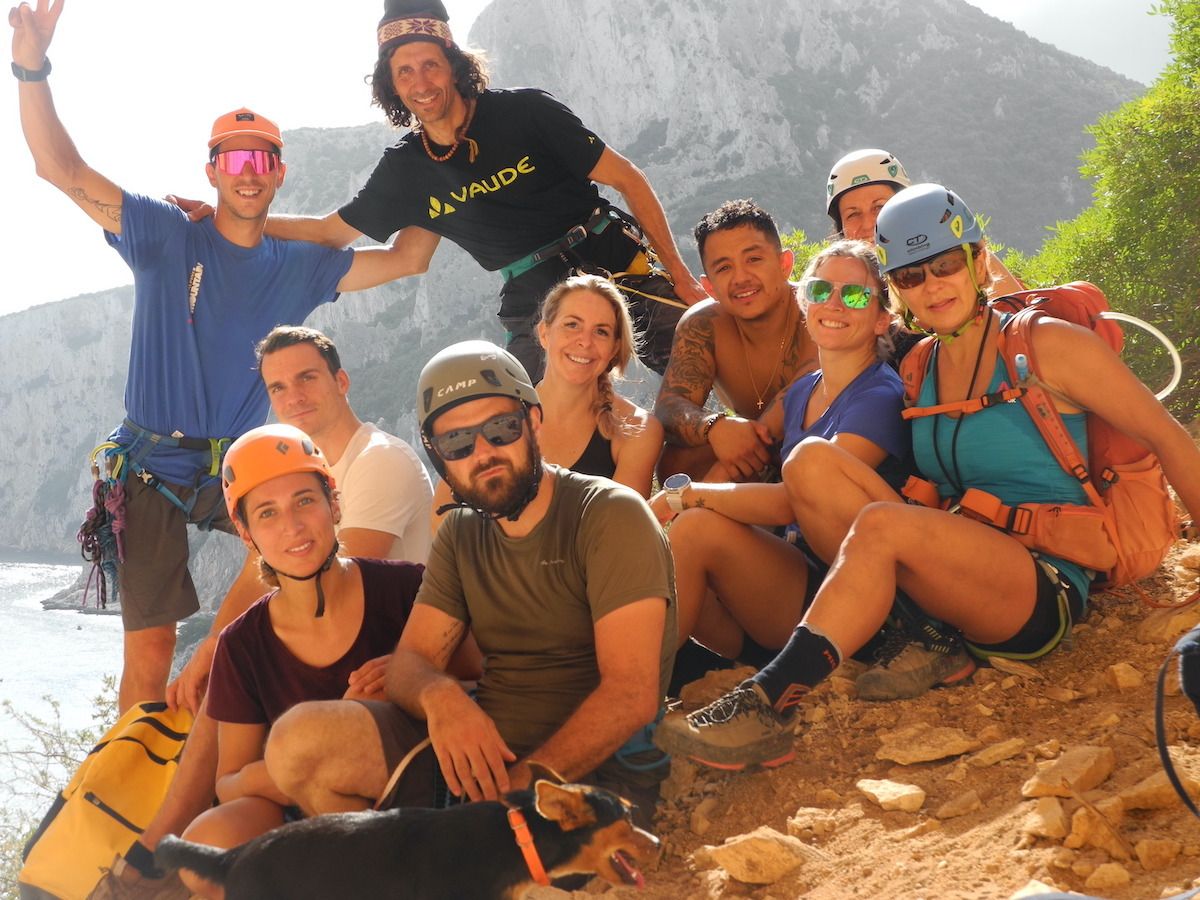
In conclusion, Sardinia shines as an outdoor sports haven, offering a rich palette of climbing and hiking experiences. Climbers relish in the diverse opportunities, from sport climbing to challenging multi-pitch routes, set against the backdrop of Sardinia's varied seasons. Areas like Cala Gonone and Baunei provide a wealth of routes that cater to different skill levels and preferences. Meanwhile, hikers can embark on the Selvaggio Blu trek, a journey through breathtaking landscapes and timeless paths. For those seeking a blend of adventure and affordability, Mapo Tapo's hiking and climbing trips tp Sardinia present a cost-effective way to explore the island’s climbing and hiking wonders, making the Sardinian vast natural beauty accessible to all.

